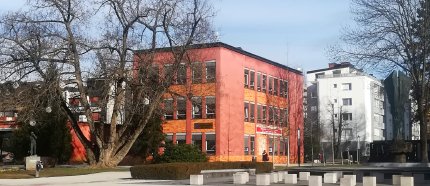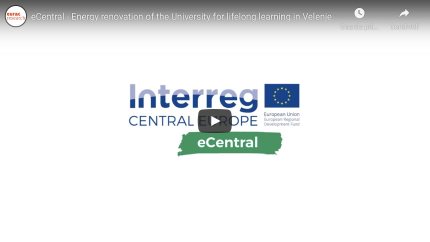PILOT ACTION 3 - SLOVENIA
Renovation and enlargement of 'Ljudska univerza Velenje' building in Velenje

'Ljudska univerza Velenje' building
- 1. GENERAL DESCRIPTION
The Lifelong Learning University in Velenje is celebrating its 60th anniversary this year. It is as old as our city. Initially, the Lifelong Learning University, with its programmes and content, acted as a link between the immigrant miners and their families in their new hometown. Since then, it has continuously offered interesting and quality educational programmes, building competences, relationships and intergenerational dialogue for six decades.
Since the building was built 60 years ago and is therefore energy-efficient and important for the residents of the area, we will renovate it.
The renovation of the Lifelong learning University building will pursue the objectives of Directive 2010/31/EU on the energy performance of buildings. The Directive requires that all newly constructed public-sector buildings after December 31, 2020 be nearly Zero Energy Buildings (nZEB), the same conditions apply for the complete renovation of all public sector buildings.
The renovation will take place in two phases. In the first phase, we will replace the lighting in the building and repair the parts of the building where the energy loss is greatest (partial change of the porches). We will also install a solar power plant on the roof, which will allow the use of electricity from renewable sources.
Target is to reach primary energy consumption of 65 kWh/m2 or under, which will qualify this building as nZEB. This would mean yearly savings of electric energy of 19.847 kWh (86,3%) and yearly energy savings of heating energy of 27.214 kWh (26,6%). The overall reduction of CO2 emissions is expected to reach 41,1% and overall energy costs per year would be reduced for around 3.245 EUR or 42,6%.
The first phase investment costs are € 112.946,12.
- 2. ENERGY RENOVATION STRATEGIES
PLANNING PHASE
In the planning phase, in addition to the project team from the municipality, the following participated:
- KSSENA as a consultant meeting nZEB standard
- Architect Rok Poles as an expert on the visual image of the building
- Institute for the Protection of Cultural Heritage (the building is under cultural heritage)
- Adesco d.o.o. External contractor for inventory of works, materials, required approvals for renovation
The aim was to find out how the reconstruction will work, what is the most economically efficient approach for reconstruction and how to provide the necessary resources for reconstruction.
KSSENA prepared detailed energy audit. The process of energy auditing consists of:
- Composition of the building envelope
- Energy resources consuming appliances
- Heating systems
- Hot water preparation
- Electric appliances (electrical connection, transformation, distribution network, electrical switchboards…)
- Indoor and outdoor lighting
- Ventilation systems and air-conditioning
- Measurement and regulation of energy consumption
- Composition of the building envelope
- Energy resources consuming appliances
- Heating systems
- Hot water preparation
- Electric appliances (electrical connection, transformation, distribution network, electrical switchboards…)
- Indoor and outdoor lighting
- Ventilation systems and air-conditioning
- Measurement and regulation of energy consumption
For the calculation of the energy performance of building physics it was used URSA calculation tool.
DESIGN PHASE
In the design phase, in addition to the project team from the municipality, the following participated:
- KSSENA as a consultant meeting nZEB standards
- Adesco d.o.o. External contractor for inventory of works, materials, required approvals for renovation
- the municipality's finance department as a consultant in the implementation of the financing test model
- the legal department as an advisory body in the legislative aspect of the implementation of test funding
- Roman Avsec as an outsourcer to develop an online platform for test co-financing
The target of this phase was to obtain actual calculations for the required materials and works of the estimated investment and to prepare the overall strategy (legislative, financial and technically appropriate and strategic in terms of marketing and implementation of test co-financing.
KSSENA subcontracted the detail feasibility study, where we received detail financial calculation with estimation of LCC. Since the document was outsourced we cannot provide information about used tools, etc...)
- 3. FINANCIAL MODEL
Following the selection of the co-financing test model, which in our case is crowdfunding, a strategy and action plan for the management of multi-financing campaign for the energy renovation of the Lifelong university. The Action Plan defines the goals of the campaign, the way they are achieved, the cost and time of the campaign, the choice of the crowdfunding model and the crowdfunding platform, the campaign team, the communication channels, etc.
Despite a very well-prepared campaign, the campaign failed to reach the pledged amount of money (€ 10.000,00) to be raised.
Reasons for not reaching the goal are:
- Goal too high
- Legislative barriers to crowdfunding (a whole new way to raise funds in Slovenia)
- The first example of this type of fundraising - people do not know it enough
- General public opinion that the municipality, because it already collects taxes, has to pay for the renovation itself

